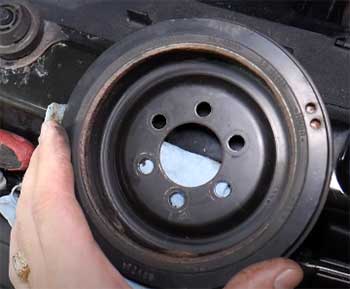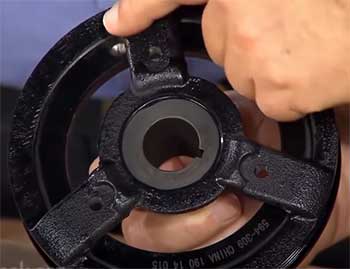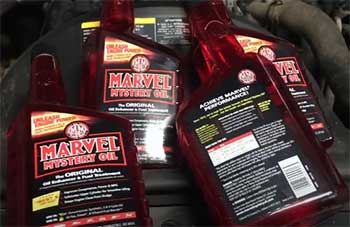A crankshaft pulley is a steel core with an internal rubber part, whereas a harmonic balancer is a round disc made of rubber and metal. The first one is available in two types, whereas the latter has three options.
Are you confused about the difference between a crankshaft pulley vs. harmonic balancer?
Though both parts play a vital role in an automobile engine, their functionality and mechanism differ. Both components are necessary for engines due to their different placements.
A Quick Comparison Table
| Specifications | Crankshaft Pulley | Harmonic Balancer |
| Material | A steel core with an internal rubber part | A round disc made of rubber and metal |
| Type | A serpentine-type and a V-belt system | Elastomer, fluid, and friction |
| Main function | Distributes power from the crankshaft to other parts | Absorbs and removes unwanted vibration |
| Balanced System | Fully internally balanced | Externally balanced with the engine |
| Location | Mounted on the end of the crankshaft | free (accessory drive) end of the crankshaft |
| Lifespan | 70,000 miles or around 20 years | 50,000 miles or a lifetime |
| Price Range | Medium to high | Low to medium to high |
Key Differences Between Crankshaft Pulley And Harmonic Balancer
- Material

A crankshaft pulley is a steel core with an internal rubber part.
The overall weight of this part has a lightweight construction, causing less force to others close by components.
In contrast, harmonic balancers have a round disc made of rubber and metal.
It usually has two pieces of disks that are carefully assembled and balanced to prevent any vibrations.
- Type
Crankshaft pulleys are available in two types. A serpentine-type crankshaft pulley is compatible to use with engines that have only a single belt. You can utilize either side to drive it.
A V-belt system comes in handy if your vehicle engine has more than one V-belt. It can handle up to 4 belts. You can drive the belt drive without any slippery issues.
On the other hand, harmonic balancers have three types of balancers. Its elastomer can absorb a huge amount of vibration to prevent damage to the engine gradually.
Friction-style dampers can provide the optimal energy dissipation for every cycle, ensuring a consistent cyclic pattern. The unwanted flexing energy is consumed by its fluid type.
Also Read: Differences between Liquid Spring And Kelderman Suspension System.
- Main Function
The main job of a crankshaft pulley is to distribute power from the crankshaft to other parts. Apart from sustaining quiet operation, it reduces rotating mass.
Moreover, a crankshaft pulley plays a key in transmitting mechanical torque for driving vehicle tires. It mainly aids in moving the auxiliary parts of the engine.
In contrast, harmonic balancers consume unnecessary vibrations. This automobile part safeguards your engine when intense action of the crankshaft.
Your vehicle’s engine will likely shake significantly with a functional harmonic balancer. If you continue running the engine at a higher speed for a long time, it may create a risky situation.
- Balanced System

A crankshaft pulley is fully internally balanced instead of externally balanced.
The reason is that it can prevent counterweight issues.
Otherwise, it will cause the crankshaft to flex at an increased rpm, leading to more fuel consumption.
The engine would struggle to work smoothly.
On the contrary, Harmonic balancers are externally balanced. This especially comes in handy when the crank’s counterweights are not heavy enough.
It creates a balanced situation for the pistons and rods of the engine. This makes them well fitted for most crate engines. Plus, they have better safety ratings due to Non-SFI Degree Markings.
- Location
A crankshaft pulley is located at the mounting area on the end of the crankshaft. It may take around 1 to 1.5 hours to replace a standard crankshaft pulley using a half-inch drive impact gun.
But sometimes, a torque wrench comes in handy too. Its precise location allows the parts to transfer energy smoothly from the crankshaft to the other systems in the engine.
On the flip side, harmonic balancers are bolted (accessory drive) at the front end of the crankshaft. It may take around 4 to 7 hours to change a harmonic balancer.
Since this vibration dampener is a part of the crankshaft, you need to remove the crankshaft to disassemble the balancer. The engine model and your skill level will affect the timing.
- Lifespan
The average lifespan of a crankshaft pulley can be around 70,000 miles. It can last at least 20 years easily. But your using frequency and maintenance affect its durability.
On the contrary, harmonic balancers can last a lifetime if you take care of the engine appropriately. But they may last around 50,000 miles on average.
- Price Range
The average price of a crankshaft pulley can be anywhere from $350 and $400 or more, depending on the car model. But an aftermarket crankshaft pulley will cost less.
On the contrary, harmonic balancers can cost around $50 to $500, depending on the brand, model, and engine compatibility. Make sure it meets the OEM standards.
Which Option Is The Best For Your Vehicle Engine?
Since both automobile parts are designed for a particular purpose, your car engine needs both a crankshaft pulley and a harmonic balancer.
Both components play a key role in protecting the exact crankshaft of your vehicle’s engine. In addition, a steel harmonic balancer is a better choice if you everyday use your car. It offers torsional dampening.
Besides, you should avoid using a lousy crankshaft pulley. A few common symptoms are the failure of a power steering pump, irregular engine idle, dead alternator, damaged transmission, etc.
Choosing a compatible crankshaft pulley is crucial to ensure a smooth operation of the engine and a perfect transformation of rotational motion from linear motion.
Using a faulty crankshaft pulley for a long time will cause severe damage to the internal combustion engine. After all, this automobile part protects the engine from extreme fatigue.
Also Read: Is Duralast Alternator Worth It?
Frequently Asked Questions (FAQ)
No, both are two different parts attached to the crankshaft. A crankshaft pulley is a steel core with an internal rubber part that distributes power from the crankshaft to other regions. In contrast, a harmonic balancer is a round disc that absorbs and removes unwanted vibration.
A harmonic balance sometimes does the job of a pulley, especially for accessory drive belts. It can help to run the water pump, alternator, A/C compressor, and other parts like a harmonic balancer.
A harmonic balancer is directly connected to the crankshaft. These automobile parts have three sections. Its hub is located in the middle area of the crankshaft, bolted to the balancer.
A crankshaft pulley directly attached to the crankshaft plays a crucial role in power from the crankshaft to other vehicle accessories by taking help for one or several belt systems.
Bottom Lines
Now, you know the core difference between a crankshaft pulley vs. harmonic balancer. Each automobile part is specially engineered to run the vehicle engine smoothly. Your car engine will fail to run operate if the drive belts are not turning continually.
And, guess who takes the credit? It is a functional crankshaft pulley that is located at the edge of the crankshaft. Several automobile parts will shake immensely if the harmonic balancer doesn’t absorb the vibrations.
This may lead to hazardous issues if you drive at higher speeds.


thank you for the information